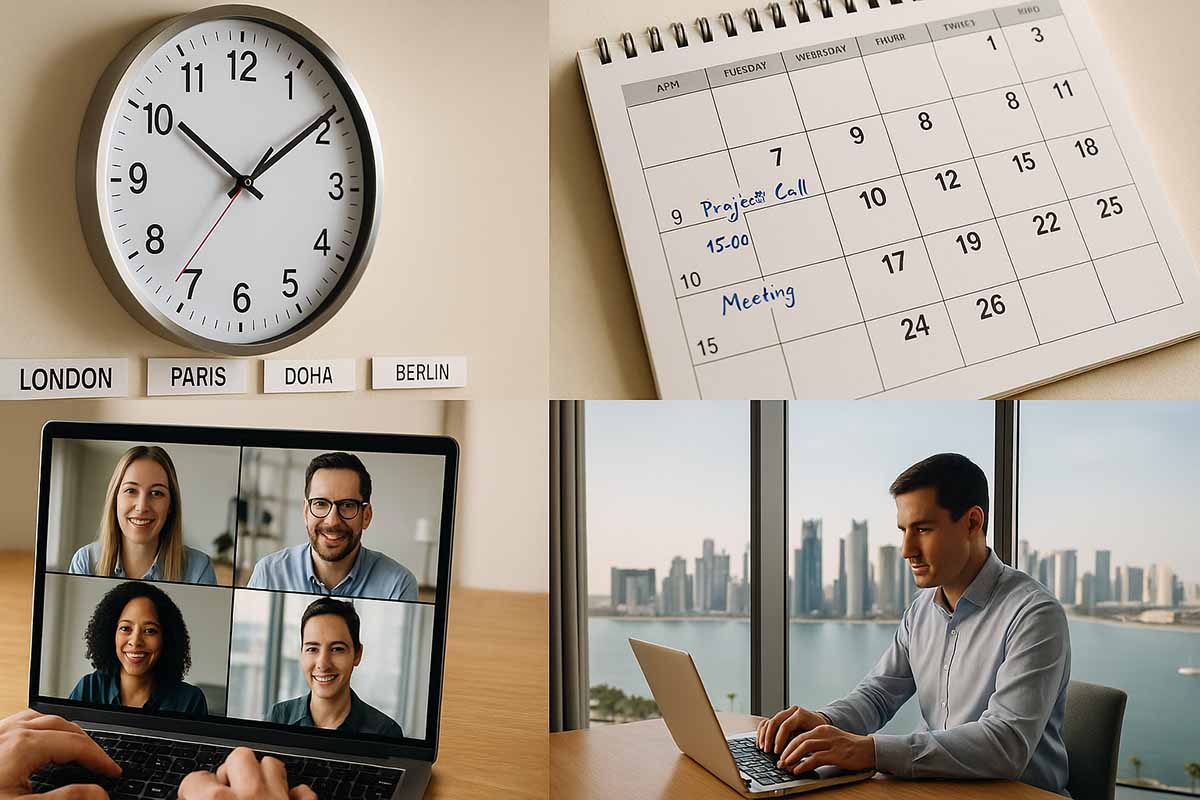Coordinating with Europe from the Qatar Time Zone: A Practical Guide for Global Teams
Work today often stretches across borders and time zones. If you are based in Qatar and working with clients or colleagues in Europe, managing time differences becomes your first strategy. The gap may be small, but it changes during parts of the year due to daylight saving in many European countries. When working hours are clear for both sides, approvals move faster, content calendars flow smoothly, and back-and-forth messages are reduced.Key Points at a Glance
-
- Qatar operates on UTC+3 year-round without daylight saving.
-
- Most of Europe changes clocks on the last Sunday of March and October.
-
- Best overlap for calls: late morning to early afternoon in Qatar.
-
- Use world clocks in calendars and always note the time zone in invitations.
Why Time Alignment Matters
A time that feels convenient to you might fall during someone’s commute home in Madrid or dinner hour in Helsinki. If schedules don’t align, decisions are delayed and momentum suffers. The good news is that Qatar and Europe are not far apart. Midday meetings in Doha usually catch the morning or early afternoon in most European cities, where teams often follow current CET. For social media teams, late approvals slow down campaigns. For sales, client time is vital. By planning overlap early, workflows become lighter and collaboration feels more natural.Quick Guide to Regional Time Differences
Qatar stays at UTC+3 all year. Europe varies by city and season. Here’s a simplified reference:| European Region | Standard Time | Summer Time | Gap from Qatar |
|---|---|---|---|
| Western Europe (Lisbon) | UTC+0 | UTC+1 | +3 hours standard, +2 hours summer |
| United Kingdom | UTC+0 | UTC+1 (BST) | +3 hours standard, +2 hours summer |
| Central Europe (Berlin, Paris, Rome) | UTC+1 (CET) | UTC+2 (CEST) | +2 hours standard, +1 hour summer |
| Eastern Europe (Athens, Helsinki) | UTC+2 (EET) | UTC+3 (EEST) | +1 hour standard, same in summer |
Best Meeting Windows from Qatar
Generally, 9:00 to 15:00 in Doha provides the best overlap with Europe. The table below assumes a 9:00 to 18:00 workday on both sides:| Target Region | Comfortable Window (Qatar) | Equivalent in Europe (Standard) | Equivalent in Europe (Summer) |
|---|---|---|---|
| Central Europe | 11:00–15:00 QA | 09:00–13:00 CET | 10:00–14:00 CEST |
| United Kingdom | 12:00–16:00 QA | 09:00–13:00 UK | 10:00–14:00 BST |
| Western Europe | 12:00–16:00 QA | 09:00–13:00 WET | 10:00–14:00 WEST |
| Eastern Europe | 10:00–14:00 QA | 09:00–13:00 EET | 10:00–14:00 EEST |
How Daylight Saving Affects Europe
Most European countries shift clocks on the last Sunday of March and again on the last Sunday of October. In summer, the gap with Qatar narrows. For example, the two-hour difference with Central Europe becomes just one. To prevent confusion in spring and autumn, set reminders a week before the change. If a launch or major campaign falls in that period, finalize the schedule earlier. Avoid meetings on the actual change days, as calendar invites often cause mix-ups then.Setting Up Calendars and World Clocks
Life is easier when you see multiple cities’ times in one view. Google Calendar allows you to add a secondary time zone and a world clock. Outlook lets you display up to three time zones. Choose Doha as your base, then add London, Berlin, and Helsinki. In invites, write times like “13:00 QA / 10:00 CET” so no one needs to calculate. Scheduling links should show availability only within the best overlap windows. If teams rotate, pre-set recurring slots for Europe-facing work, such as “Mon–Thu 11:00–15:00 QA.” A consistent pattern builds smoother alignment.Clear Communication in Email, Chat, and Calls
Coordination improves when expectations are transparent. State when you are usually online and which hours are open for calls. Use specific subject lines in emails and include deadlines with the recipient’s time zone, like “EOD Berlin.” In chat, add context and link documents to reduce back-and-forth. If fast input is needed, ask if a short standup call is possible. For creative reviews, send a short video or annotated file to cut down on meeting length.A Story from the Field
A content studio in Doha worked with a client in London and a production partner in Munich. Initially, three email threads were needed for one approval. After adding world clocks to calendars and setting two to three daily slots, things sped up. They chose 13:00 QA for joint calls. In standard time, that was 10:00 in the UK and 11:00 in Germany. In summer, it became 11:00 in the UK and 12:00 in Germany. Both worked comfortably, so the link and schedule stayed the same year-round. Every Monday, they set weekly goals at 13:00 QA. Wednesday check-ins happened at 12:30 QA. On Fridays, wrap notes were shared at 11:30 QA for the week ahead.Sample Weekly Rhythm for Global Teams
-
- Monday: Planning call at 13:00 QA with the European core team. Set deliverables and assign reviewers.
-
- Tuesday: Asynchronous feedback via document comments with clear deadlines based on reviewer’s time zone.
-
- Wednesday: Short huddle at 12:30 QA, limited to 20 minutes, focused only on blockers.
-
- Thursday: Production and quality checks during the established overlap hours.
-
- Friday: Soft cutoff at 11:30 QA with a status note time-stamped in the client’s zone.
